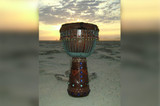Yankadi Rhythm: It Is Good to Be Here
There are basic drumming rhythms for the djembe. One of those basics is called the yankadi rhythm. Once you have heard it, you will know it, as it is a slow rhythm, encouraging one to get up and celebrate the ancestors or simply march in a procession down to the ocean and pay tribute to an Orisha. The sound is at once distinct and provocative. While there are books available to help a drummer interested in learning this rhythm, they are not the most reliable source. It is probably best to learn this rhythm from a djembefola, something that may be said of most djembe rhythms.
The history of the yankadi rhythm is interesting. It is a traditional seduction dance for young women and has most often been played as young women and men demonstrated their dance moves for one another. Those young people would come to another town or village and show the people there what they could do. Throughout history, how one moved one’s body told a lot about future potential and worth. This seduction dance would have been a significant part of life in the past. These days, the yankadi rhythm is played for a variety of occasions, but still seems to call listeners to move seductively.
The yankadi is a slow portion of a larger meal. The faster part that generally accompanies the yankadi rhythm is called the makru. Some say the origins of the yankadi lay with Burkina Faso composers. Yankadi can be said to mean “it is good here” and was played to let people know good places to settle. Over time, possibly as people began to have more permanent settlements, the rhythm took on a more personal usage. The young people of Lower Guinea would have been used to young women using the yankadi rhythm to entice and flirt with young men they admired.
The West African nation of Guinea has an extensive list of djembe rhythms for specific purposes. There are drum rhythms for handling conflict between males, for celebrating certain types of prestige within communities, and, of course, for seduction. The Sosos, a particular ethnic group in Lower Guinea, are given the credit for the yankadi rhythm by some who study these matters. It is interesting to note the difference in opinion about the rhythm’s origination, as Burkina Faso and Guinea are currently separated by Mali and Côte d'Ivoire (or the Ivory Coast); however, in history, such human-endorsed boundaries did not exist.
Recent Posts
-
What is the Best Size Djembe for Beginners?
If you're new to the world of percussion and interested in learning the djembe, you're in for a t …16th Jul 2024 -
The Benefits of Becoming a Drumming Teacher: Transforming Passion into Profession
Why become a drumming teacher? Becoming a drumming teacher is an excellent way to share your pas …22nd May 2024 -
What Makes the Djembe Drum a Spiritual Instrument in African Music?
Origin and history of the Djembe drum The Djembe drum originates from West Africa and holds sign …16th May 2024




